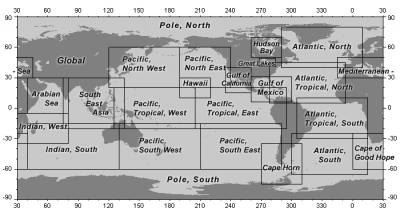Difference between revisions of "QuikScat"
(Created page with "QuikScat is an offshore wind dataset based on remote sensing from a satellite instrument. The QuikScat wind data are derived from a remote sensing microwave scatterometer tha...") |
|||
| Line 3: | Line 3: | ||
The QuikScat wind data are derived from a remote sensing microwave scatterometer that is mounted on the QuikScat satellite; the satellite was launched in June 1999. The scatterometer is a special type of radar that is used to analyze the roughness of the sea. This fine scale roughness is highly correlated to near-surface winds and directions – and as such it is possible to infer the wind conditions based on the scatterometer data. | The QuikScat wind data are derived from a remote sensing microwave scatterometer that is mounted on the QuikScat satellite; the satellite was launched in June 1999. The scatterometer is a special type of radar that is used to analyze the roughness of the sea. This fine scale roughness is highly correlated to near-surface winds and directions – and as such it is possible to infer the wind conditions based on the scatterometer data. | ||
| − | The QuikScat dataset at EMD currently holds 10 meter wind speed derived from the fine scale surface roughness of the sea surface. According to the documentation on the QuikScat data, the wind corresponds to an 8-10 minute averaged wind speed [ ]. The temporal coverage is at maximum 2 times a day, but with a number of gaps with data missing due to problems, such as the instrument being turned off. The spatial coverage is near global for sea areas with a resolution of 0.25 degrees. The spatial coverage is shown in | + | The QuikScat dataset at EMD currently holds 10 meter wind speed derived from the fine scale surface roughness of the sea surface. According to the documentation on the QuikScat data, the wind corresponds to an 8-10 minute averaged wind speed [ ]. The temporal coverage is at maximum 2 times a day, but with a number of gaps with data missing due to problems, such as the instrument being turned off. |
| + | |||
| + | == Spatial Coverage == | ||
| + | The spatial coverage is near global for sea areas with a resolution of 0.25 degrees. The spatial coverage is shown in figure below. | ||
| + | [[File:CoverageQuikScat.png|center|thumb|400px|Spatial Coverage of the QuikScat Dataset]] | ||
| + | |||
== External Links == | == External Links == | ||
Homepage for the QuikScat data: [http://www.ssmi.com/qscat/ http://www.ssmi.com/qscat/]. | Homepage for the QuikScat data: [http://www.ssmi.com/qscat/ http://www.ssmi.com/qscat/]. | ||
Revision as of 10:57, 26 May 2013
QuikScat is an offshore wind dataset based on remote sensing from a satellite instrument.
The QuikScat wind data are derived from a remote sensing microwave scatterometer that is mounted on the QuikScat satellite; the satellite was launched in June 1999. The scatterometer is a special type of radar that is used to analyze the roughness of the sea. This fine scale roughness is highly correlated to near-surface winds and directions – and as such it is possible to infer the wind conditions based on the scatterometer data.
The QuikScat dataset at EMD currently holds 10 meter wind speed derived from the fine scale surface roughness of the sea surface. According to the documentation on the QuikScat data, the wind corresponds to an 8-10 minute averaged wind speed [ ]. The temporal coverage is at maximum 2 times a day, but with a number of gaps with data missing due to problems, such as the instrument being turned off.
Spatial Coverage
The spatial coverage is near global for sea areas with a resolution of 0.25 degrees. The spatial coverage is shown in figure below.
External Links
Homepage for the QuikScat data: http://www.ssmi.com/qscat/.
